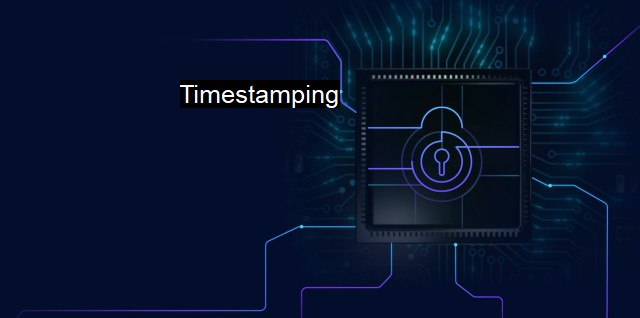What is Timestamping?
Importance of Timestamping in Cybersecurity Measures: From File Integrity Checking to Malware Analysis and Forensic Investigations
Timestamping is a critical process actively used in multiple sectors, involving recording the exact time an event occurs. In computer science, notably in the realms of cybersecurity and antivirus operations, timestamping is an essential feature. It plays a substantial role in securing and validating the integrity and authenticity of specific actions within computer systems and networks.Timestamping ensures every event or data modification related to an information system records a date and time. This procedure is essential in capturing "when" a particular action happens. One primary function of timestamping in cybersecurity is digital signatures. These signatures ensure the integrity of the messaged content, proving it has not been tampered with since its transformation into cryptographic form.
When a behavior-based antivirus detects unexpected activities such as an unusual transaction or file modification; a timestamp can assist in tracing the actions back to their respective malwares or cyber threats. Therefore, a timestamp imparts the necessary visibility to spot the origin of any malicious computer-based activity. Including a time-stamp with every antivirus alert allows administrators to track the chronology of virus infections or attacks and monitor any consequent action swiftly.
Digital timestamping further assures the chronological sequence of a chain of events in a system or network. This concurrent functionality is essential in maintaining anti-malware systems and log managing applications. Log management tools need precise timestamps to sort, categorize, and evaluate the order and correlation among numerous logged events. Logging tools with reliable time-stamping can make thread detection more effective by offering clearer views of cybersecurity incidents.
Every timestamp should be reliable as it is an integral aspect of malware detection and forensic investigations in a cybersecurity context. Timestamp accuracy and integrity determine the efficacy of security audits, investigations, and protective measures significantly. If malicious actors manipulate timestamps to appear benign or make their actions seem as out-of-sequence, it can obstruct the determination process of intrusive activities or malware infestations, making it harder to anticipate the source or motive of the attack.
Timestamping holds further importance in encrypted communications where timestamps prove their worth in the cases of time-sensitive security protocols. Protocols relying on timestamping ensure the validity and integrity of communication attempts. In such a case, anticipatory mechanisms can identify and refuse outdated or repeated messages, mitigating replay attacks used by cybercriminals to trick systems into granting unauthorized access.
The standard of preciseness in timestamping also has widespread implications for cybersecurity. The coordination of clocks affects the validity of SSL/TLS certificates, which are critical for secure web browsing. Without accurate timestamps recorded in real-time, it becomes substantially challenging to identify and verify the chronology of several actions performed in a system, diluting the potential of any investigative scrutiny.
The trustworthiness and the precision of timestamping act as support structures for the entire cybersecurity sphere. even timestamping is prone to potential manipulation aiming to distort the overall security narrative within a system or application. Therefore, it becomes imperative to protect the integrity of timestamps just as much as we protect the data they mark in a digital environment replete with persistent security threats.
Timestamping serves as an indispensable feature in ensuring system integrity, managing logged events, securing encrypted communications, and facilitating cyber forensics investigations amidst antivirus actions. It hence provides a robust yet often overlooked line of defense in the cybersecurity armor: a silver thread intertwining within the mesh of advanced cybersecurity defenses.

Timestamping FAQs
What is timestamping and why is it important in cybersecurity?
Timestamping is the process of recording the time and date of an event, such as the creation, modification or access of a file, to establish the sequence of events during an investigation. It is important in cybersecurity because timestamps can provide key evidence in forensic investigations, helping to determine when a security breach occurred and who was responsible for it.How does timestamping help in virus detection?
Timestamping can be used to track the origin of a virus, identify when it was first detected, and determine the extent of the damage it has caused. By checking the timestamp of a file, antivirus software can determine whether it has been modified or tampered with, and therefore whether it may contain a virus or other malware.What are the different types of timestamps?
There are different types of timestamps, including system timestamps (created by the operating system), network timestamps (created by network devices such as routers), and user timestamps (created by users). System timestamps are the most reliable and accurate, as they are created by the operating system rather than external devices.Can timestamps be faked or altered?
It is possible to fake or alter timestamps, which is why it is important for cybersecurity professionals to use a variety of tools and techniques to verify the accuracy and validity of timestamps. To prevent timestamp tampering, some organizations use cryptographic timestamping, which uses digital signatures to verify the authenticity of a timestamp. Additionally, timestamps should always be accompanied by other forms of evidence, such as logs and audit trails, to support their validity in court.Related Topics
Digital signature Certificate authority Public key infrastructure (PKI) Malware analysis Secure sockets layer (SSL)
| | A | | | B | | | C | | | D | | | E | | | F | | | G | | | H | | | I | | | J | | | K | | | L | | | M | |
| | N | | | O | | | P | | | Q | | | R | | | S | | | T | | | U | | | V | | | W | | | X | | | Y | | | Z | |
| | 1 | | | 2 | | | 3 | | | 4 | | | 7 | | | 8 | | |||||||